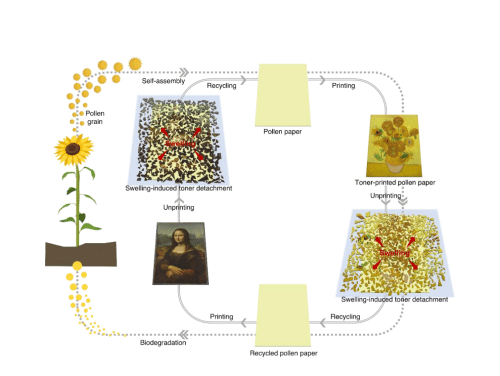Scientists at Nanyang Technological University in Singapore (NTU Singapore) have created a pollen-based ‘paper’ that can be ‘erased’ and reused several times without causing damage to the paper – a great development for printed electronics!
They showed how high-resolution colour images could be printed on non-allergenic pollen paper with a laser printer, then ‘unprinted’ with an alkaline solution by entirely removing the toner without destroying the paper. They showed that this technique could be repeated up to eight times in total.
According to the NTU team lead by Professors Subra Suresh and Cho Nam-Joon, this revolutionary, printer-ready pollen paper could become an eco-friendly alternative to traditional paper, which is manufactured through a multi-step process with a major negative environmental impact. It could also assist to cut down on the carbon emissions and energy consumption connected with traditional paper recycling, which includes repulping, de-toning (removing printer toner), and rebuilding.
“By integrating conductive materials with the pollen paper, we could potentially use the material in soft electronics, green sensors, and generators to achieve advanced functions and properties”, says Professor Cho.
Professors Cho and Suresh and their research team previously shown that pollen paper could bend, coil, and even crawl like a caterpillar in response to changes in air moisture, making it a promising contender for soft robotics applications. The same group also demonstrated that by printing different patterns on pollen paper, they could induce it to fold up into distinct 3D forms.

The NTU scientists used a laser printer to create a painting from Vincent Van Gogh’s Sunflowers series to illustrate the printability of their sunflower pollen paper. They discovered that the paper went through the printer without tearing or being damaged.
After that, they “unprinted” the same thing. For laser printing, this unprinting entails loosening the link between the toner powder and the paper. The scientists achieved this by putting the paper in an alkaline lab reagent for two minutes and gently rubbing it.





